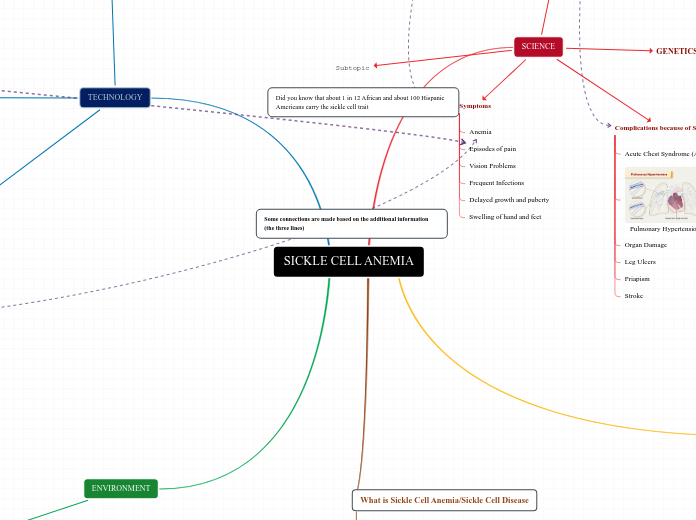SICKLE CELL ANEMIA
SCIENCE
GENETICS
This Punnett square shows the chances of SCA, and it is recessive.
This pedigree presents SCA in an
autosomal recessive pattern.
This shows the inheritance of the normal
versus sickle hemoglobin being passed on.
(More info in the side three lines)
Mutation that causes SCA
Complications because of SCA
Acute Chest Syndrome (ACS)
Pulmonary Hypertension
Organ Damage
Leg Ulcers
Priapism
Stroke
Symptoms
Anemia
Episodes of pain
Vision Problems
Frequent Infections
Delayed growth and puberty
Swelling of hand and feet
Subtopic
SOCIETY
Living with SCA
Routine Follow Up Care
See your doctor regularly
Get your vaccines
Managing Pain
Drink Plenty Fluids
Avoid Extreme Temperatures
Be careful with high altitudes
Avoid Alcohol and Smoking
Adopting a healthy lifestyle
Regular Exercise, Making sure
it is not too strenous
Eating Well
Psychological Causes
Self-Isolation among adolescents
Anxiety
Depression
Sickle Cell Awareness Month
Every September, it is sickle cell
awareness month with a goal to raise
awareness about it and how it impacts many people.
It is represented by the colour burgundy
What is Sickle Cell Anemia/Sickle Cell Disease
A genetic disorder that is caused by a defect on chromosome 11.
Description of Sickle Cell Anemia
Inherited red blood cell disorder in which there aren’t enough healthy red blood cells to carry oxygen throughout your body
The red blood cells are shaped like “crescent moons”
These rigid, sticky cells can get stuck in small blood vessels which can slow or block blood flow and oxygen to the body.
TECHNOLOGY
Diagnoses
Blood Test
Newborn Screening
Amniocentesis
Chorionic Villus Sampling (CVS)
TREATMENT
Medications/Drug Therapy
Hydroxyurea (Droxia, Hydrea, Siklos)
Endari (L-glutamine oral powder)
Adakveo (Crizanlizumab)
Voxelator (Oxybryta)
Surgical Procedures
Blood Transfusions
Stem Cell Transplant
Experimental Treatments
Gene Therapy
Nitric Oxide
Drugs to boost
fetal hemoglobin
production
ENVIRONMENT
TEMPERATURE
Many people with SCA Live in tropical countries
hemoglobin molecules stick to each other forming rod-like long structures. Leads to blood cells becoming sickle shape, this causes blockages and damaging vital organs and tissues. (hemoglobin-S)
This image demonstrates the difference between Normal and Sickle Hemoglobin Cells and how the blood cells are different after the mutation.
Did you know that about 1 in 12 African and about 100 Hispanic Americans carry the sickle cell trait
Some connections are made based on the additional information (the three lines)
Point Mutation (Info in the side)
Normal VS Sickle Cells
NORMAL
transports oxygen from the lungs to other parts, red blood cells are smooth and round which glide through blood vessels (hemoglobin-A)
SICKLE
Results of the Point Mutation
Lung Tissue Damage
Acute Chest Pain
Pain Episodes
Stroke
Priapism
Can cause damage to:
